Grass Turning Yellow – Causes + Fixes to Turn it Green
With a good lawn care program, you expect your grass to grow into a thick, lush green lawn. However, for some reason, the grass can turn yellow and make the lawn appear ugly. What causes a lawn to turn yellow, and how can I fix the problem?
Grass can turn yellow due to overwatering, fertilizer burn, heat stress, or nutrient deficiency (iron, potassium, and nitrogen). Water your lawn 1-2 times weekly to keep the soil moist. If you recently overfertilized, flush out excess salts with water to stop the yellowing and then apply a slow-release organic fertilizer.
Yellow grass will grow back if you fix the underlying problem soon enough. For new sod, it may turn yellow due to weather-related changes.
Table of Contents
Why is my grass turning yellow?

Grass can turn yellow while still new sod or even discolor during summer and winter months. The causes can be different and weather-related. In other cases, it could be that your dog pees or human urine on the grass and burns it into patches.
Here are the reasons why your grass is turning yellow:
Overwatering
Overwatering leads to waterlogged soil that affects the roots and, eventually, grass blades of your lawn. Too much water can mean the roots cannot absorb nutrients and oxygen from the soil to feed the plant.
The result of overwatering is suffocating roots, poorly-fed leaves and stems, and a general loss of color.
St. Augustine grass turns yellow quite easily because it is sensitive to overwatering. Heavy rainfall in your area can cause nutrients to leach beyond the root zone, causing a St. Augustine lawn to turn pale yellow and grow slowly.
Besides St. Augustine grass, new sod can easily turn yellow if overwatered because the shoots are not strong enough, and the roots are also still shallow. This often happens when you water too much, trying to make new grass grow and spread faster.
Other signs of an overwatered lawn include:
- Fungal diseases – especially in St. Augustine lawns
- Wilting grass
- Root rot
- Yellowing grass blades
In some cases, overwatering can turn your yard into muddy spots and damage the lawn completely.
Suppose your lawn is turning yellow due to overwatering. In that case, you can easily fix it by allowing the lawn enough time for the excess water to drain away and then returning to an adjusted watering schedule.
Fertilizer burn
Applying too much fertilizer on your lawn introduces excess salts that burn the grass and turn it yellow. If you recently applied a synthetic fertilizer, it is probably the reason why the turfgrass is discoloring.
Here are the signs of fertilizer burn:
- Leaf scorch due to excess nitrogen salts
- Grass tips turning brown
- Yellowing of grass blades at the base
- The presence of fertilizer crusts on the grass
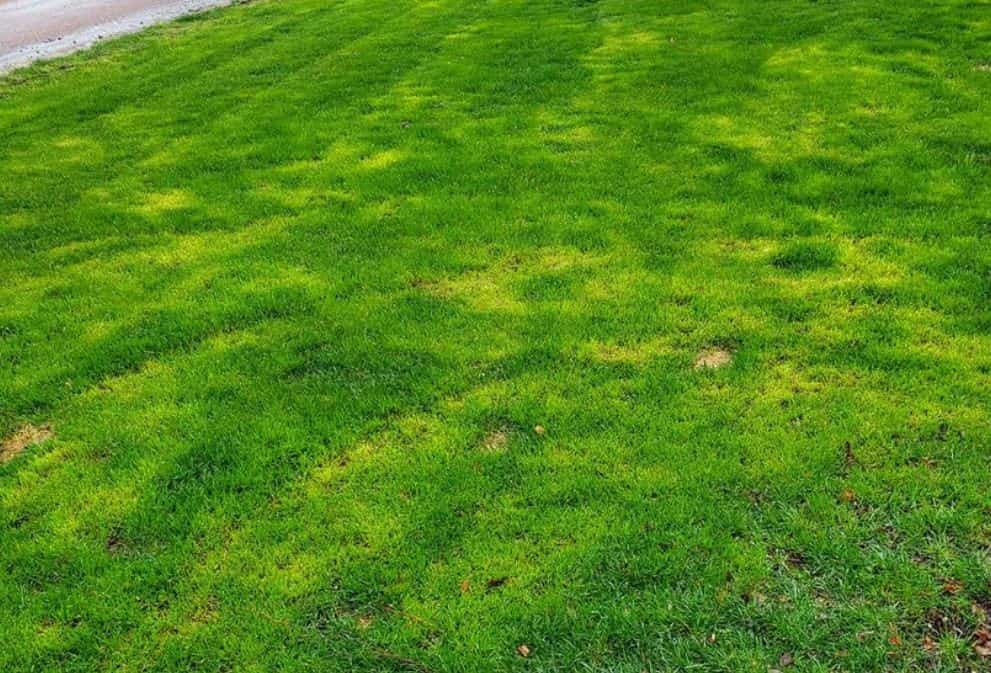
You can fix yellowing grass by flushing the excess salts through irrigation. If you aim to push your lawn to grow thicker and green up faster, apply a good organic slow-release fertilizer such as Milorganite.
Too much shade
A lawn that’s turning yellow gradually could suffer from too much shade. Most turfgrasses like the full or partial sun. When exposed to long hours of shade, the grass will turn yellow, grow sparsely with shoots appearing thin and elongated, and become susceptible to disease.
Heat stress
Heat stress is common in the summer when temperatures are high. If your lawn is not properly watered, it can suffer from drought stress and start to turn yellow. Some varieties of St. Augustine grass are not drought-resistant and can easily show signs of drought stress if a proper watering schedule is not maintained.
Grass needs moisture to grow. Hot weather and places exposed to the sun all day will dehydrate and dry out the lawn quickly, causing yellow-brown discoloration.
Other effects of high temperatures on turfgrass include the following:
- Wilting grass
- Soil compaction
- Limited water intake
- Drying and dying grass
Drought and heat stress get worse in newly established sod because the roots aren’t deep enough to absorb the little moisture left deep in the soil.
By watering deeply, you can restore and fix grass that’s turning yellow due to heat stress. However, if the lawn remains under heat stress for a long, it will be difficult to revive the dying grass.
Nutrient deficiency
Yellowing grass could also signify iron chlorosis or other nutrient deficiencies like nitrogen and potassium. Iron deficiency is characterized by green grass with sparse appearances of yellow blades. It can also manifest in grass blades having streaks of light yellow veins even when the rest of the grass blade appears green. This is called interveinal chlorosis.
On the other hand, nitrogen deficiency signs include a uniformly yellowing turf that can also be said to be turning pale green, while potassium deficiency manifests as leaves turning yellow and brown on the margins.
If parts of your lawn show a pale yellow discoloration while the rest of the lawn appears thick and green, it is probably because you’re missing applying fertilizer in those parts.
Dog urine burns
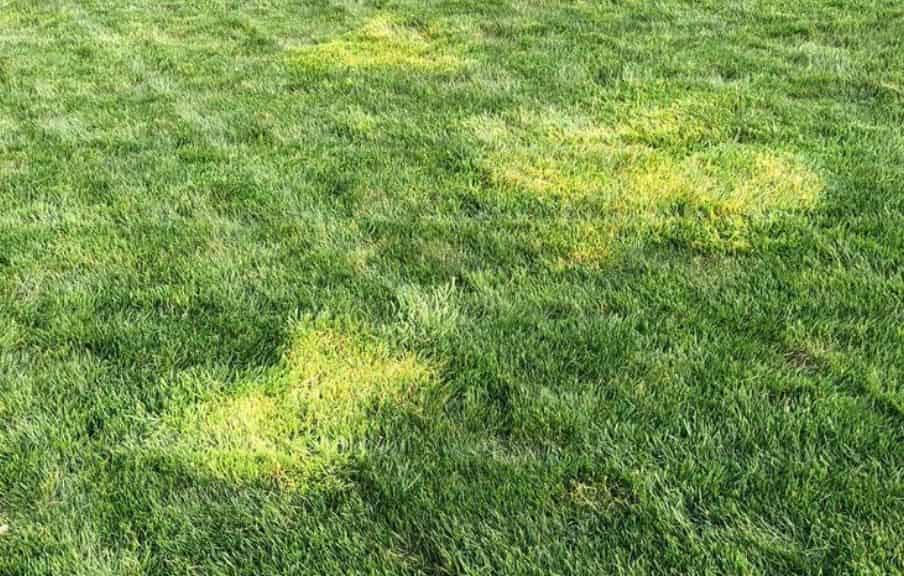
You may notice some yellow spots if you have dogs playing in the yard. Most male dogs pee at a single spot to mark their territory, so it is easier to identify that it is dog pee turning grass yellow.
When a dog pees on grass, it will turn yellow and eventually die, leaving a brown patch of grass. Some people say that the pee of female dogs is more detrimental and burns grass than that of male dogs. I’m yet to find the truth in that.
One of the best fixes to prevent dog pee burns is to use a urine neutralizer (as explained below) or train your dog to go to the restroom somewhere else.
It’s good to note human, and dog urine has the same effects as overfertilization. Both in excess lead to too much nitrogen, which leads to chemical burns to the grassroots and changes soil pH, thus, the yellowing of grass lawn.
Lawn diseases
Fungal diseases affect the appearance of leaf blades in turfgrasses. Some diseases, such as dollar spot, can manifest as yellow grass blades at the base of turfgrass.
Another possible problem is frostbite which can lead to leaf discoloration in lawns. Warm-season turfgrasses such as Zoysia and Bermuda grass can develop mottled leaves that start to discolor from yellow to brown when frostbitten.
Apply a lawn fungicide to get rid of dollar spots and grey leaf spots in your lawn and stop the yellowing and other signs of leaf discoloration. In addition, you can treat fungal diseases naturally with products available right in your home.
How to fix a yellowing lawn
It is easy to think that lawn diseases or lack of fertilizer are causing your lawn to turn yellow, but any of the reasons above can be the problem. The first step to fixing a yellowing turf is to find out the root cause.
Did you fertilize recently? Are you applying the right amount of water? Ask these questions and more in order to apply the right fix.
Here are 7 ways to fix yellow grass:
1. Flush out excess fertilizer
Fertilizer burn starts to appear when grass blades turn yellow, with the lawn appearing to have crusts of synthetic fertilizer. To fix the problem, flush out the excess salts past the root zone.
Here’s how:
Water the lawn with at least 1 inch of water per day for 4-7 days in order to wash down the excess salts and force them to leach into the soil beyond the root zone. Start this treatment as soon as you see your grass starting to turn yellow or brown.
Soaking the lawn with a generous amount of water for a week can help revive the grass and turn the lawn green again. It is possible to save a lawn that’s dying from fertilizer burn if you start the treatment early enough.
Note: To avoid such a problem, identify the grass type you have and the right amount of fertilizer for your tuffgrass.
2. Water the lawn deeply
A lawn that’s wilting and turning yellow due to water deficiency can quickly turn brown as the grass starts to die. If water is the problem, you might want to review your watering schedule to fix the yellowing:
Water the lawn deeply 1-2 times weekly to ensure that the soil remains moist even during the hottest times of the day. If the lawn is established on fast-draining sandy soils, irrigate with 1.5-2.5 inches of water to keep the grass green.
Different turfgrasses have different water requirements. Here’s how much water your lawn requires depending on the type of grass you have:
| Turfgrass | Water requirements per week |
| St. Augustine grass | 1 inch |
| Bermuda grass | 1¼ inches |
| Zoysia | 1 inch |
| Perennial ryegrass | 6 inches |
| Tall fescue | 0.8 inches |
| Kentucky bluegrass | 1.2 inches |
| Buffalograss | 0.3 inches |
Minimum water requirements can vary depending on the soil type and season. For example, apply a little more water during summer and if your turf is established on sandy soils.
3. Feed the lawn with slow-release fertilizer
Most turf grasses require about 1lb of nitrogen per 1000 sq. ft to remain healthy and fend off weeds, diseases, and pests. If the grass is turning yellow due to inadequate nitrogen, a good fertilization program should turn the grass green again.
Apply a slow-release organic nitrogen fertilizer to feed the grass constantly for 2-3 months at a time. Organic fertilizers hardly burn grass and are less likely to cause yellowing. Applying one will turn a yellowing turf green within 1-2 weeks.
Caution: Excess nitrogen can burn the roots and change the pH of the soil. This excess nitrogen generates problems with the roots’ capacity to take in other nutrients and water.
4. Apply an iron supplement
Iron chlorosis occurs in lawns that have a poor soil pH, so correcting this is the first step to fixing the yellow grass. Start with a soil pH test and make sure it is right for the variety of turfgrass you’re establishing.
After amending the soil pH, apply an iron-rich fertilizer such as Milorganite, especially if the yellowing was not caused by overfertilization.
If your lawn is well-fed yet showing signs of iron deficiency, apply an iron supplement for lawns such as Ironite. This will restore your lawn’s color to a deep green appearance and help it grow into a thick, healthy turf.
Note: Professional soil analysis may be needed to establish which nutrients are lacking so as to help maintain ideal soil pH for lawns to thrive.
5. Apply a dog urine neutralizer
Dog urine contains high concentrations of nitrogen that burn the grass when your dog pees consistently at the same spot. To fix yellow patches caused by dog urine, do the following:
- Apply a dog urine neutralizer as soon as your dog pees on the grass.
- Dig up the dead grass in those spots and reseed for new grass to grow.
- Train your dog to pee in spots in your yard that don’t have grass.
Following your dog in the yard and training him can be a tough task, but it will save your lawn from yellowing. Train your dog only to use a specific part of the garden, preferably where you do not have grass. Sometimes, dog urine spots do not re-grow, particularly when you take a long before applying a urine neutralizer.
If the grass is already dead, remove those patches using a rake and re-seed your lawn.
6. Treat for pests and diseases
Pests such as chinch bugs and grubs can cause damage to your lawn that will manifest as leaf discoloration and even dead brown patches of grass. Fungal infections are also known to cause the yellowing and greying of grass blades at the base of the shoots.
To turn yellow grass green fast, apply a lawn fungicide such as Scotts DiseaseX. It will get rid of most fungal infections that cause leaf discoloration and root rot.
For pests, apply a grub killer in early spring to prevent the larvae from feeding on the roots of your turfgrass and causing it to turn yellow-brown.
7. Fix drought stress in summer
Here’s how to stop grass from yellowing due to heat stress:
Water the lawn deeply every week. Irrigate early in the morning to give the water time to dry during the day and prevent fungus. The type of soil also will determine how fast the water drains away.
For example, grass growing in sandy soil needs more watering. Since you’ll soak about 4-6 inches of the topsoil, ensure you measure the amount of water you’re putting down in your lawn to prevent overwatering that can also make grass turn yellow.
To break the compact soil, you can use lawn aerators. They range from shoes with spikes for smaller lawns to larger gas-powered lawn aerators for larger yards. They are also designed to make holes in the soil to facilitate water infiltration.
However, be wary not to water your lawn too often, as it will get waterlogged and lead to a muddy yard. Probably, once or twice a week will be enough when it is hot, but only water your garden when necessary.
What makes new grass turn yellow?
New grass can turn yellow depending on factors like where you live, type of grass, and soil type. Newly germinated grass can start to lose color and look unhealthy if proper care and maintenance are not provided.
Here are the common reasons why new grass can turn yellow:
- Lack of fertilizer (nutrients)
- Too much water
- Lack of sunlight
- Iron deficiency
- Soil pH problems
- Fertilizer burn
- Fungi and Grubs Infestation
- Unsharpened mower blades
A new turf established in a shaded area can quickly appear to suffer from malnutrition because of inadequate sunlight. The new shoots start to elongate abnormally fast to reach for the sun. The result is a pale-yellow coloration of the grass blades.
Is yellow grass dying?
Yellow grass is not a definite sign it is dying. Grass can grow back and thrive if the underlying cause, such as overwatering, underwatering, or fertilizer burn, is fixed. To help yellow grass bounce back quickly from drought, water the lawn deeply as soon as possible to revive the dying grass.
Wilting and dying turfgrass from fertilizer burn can also die quickly if the excess nitrogen salts are not flushed out of the soil soon enough. Similarly, pests and diseases can kill grass if not treated early enough.
Yellowing in Winter
The reason why lawns turn yellow during winter is dormancy. Grass varieties that can’t tolerate the cold temperatures during winter go into dormancy and come back to life during the warmer seasons starting in spring.
Besides dormancy, winter also brings about rust and snow mold, which are fungal diseases. Also, since people use salt to clear driveways and roads, the salt builds up in the soil, making it toxic for the grass.
Warm-seasoned grasses cannot tolerate the cold, so they naturally turn yellow, while cold-seasoned grass can endure the winter. You can let the grass hibernate and “revive” it after winter or overseed with the cold season grass.
To prevent lawn rust, fertilize the lawn often, water it, and mow it as required. Also, don’t mulch the grass clippings before winter; just remove the grass clippings. You can use alternatives such as sand or pet litter to prevent the salt from building up in the soil.
Grass Yellowing in Summer
Summer brings about high temperatures, which cause heat stress. This leads to tough soil, wilting of grass, soil compacting, and discoloration of grass. As mentioned earlier, lawn diseases, pests, and dog urine could also cause the grass to turn yellow during this season.
Remember, the kind of grass seed planted makes a difference as well as the type of soil in your lawn. Some grasses can tolerate winter, while others can tolerate summer.
Regular lawn maintenance practices like mowing, watering, aerating, and using fertilizers can also help prevent grass from turning yellow. Also, don’t forget to use the right pesticides when dealing with fungal diseases that discolor your lawn.
Resources
- Brad S. Fresenburg, Division of Plant Sciences, University of Missouri: Home Lawn Watering Guide
- Dr. Richard L. Duble, Professor and Extension Turfgrass Specialist, Texas A&M University: Iron Chlorosis in Turfgrass
- University of California Agriculture & Natural Resources: Nutrient deficiencies on lawns

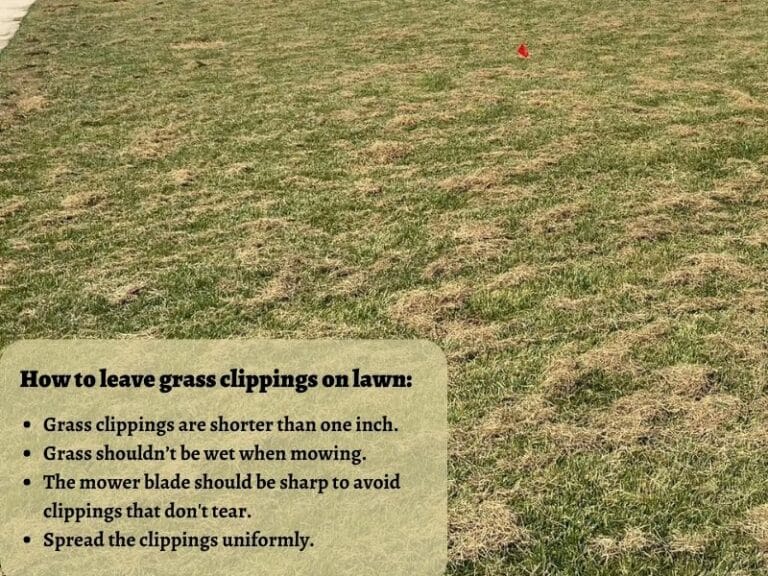
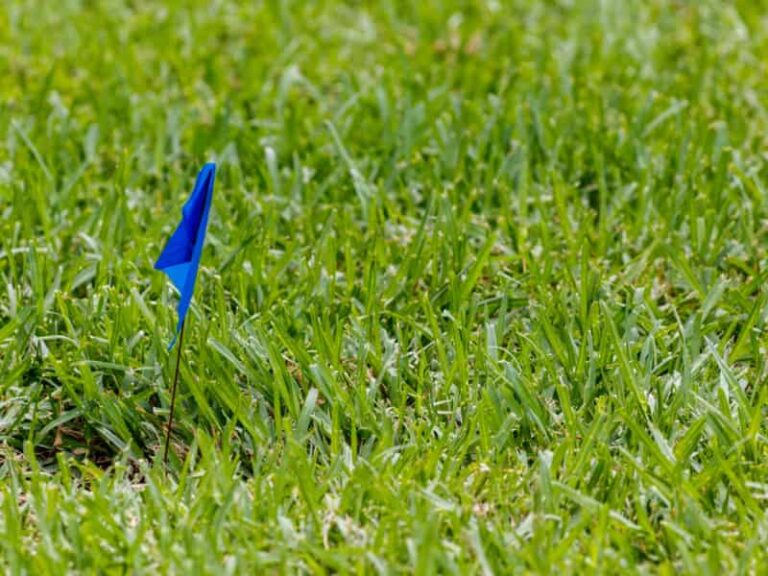
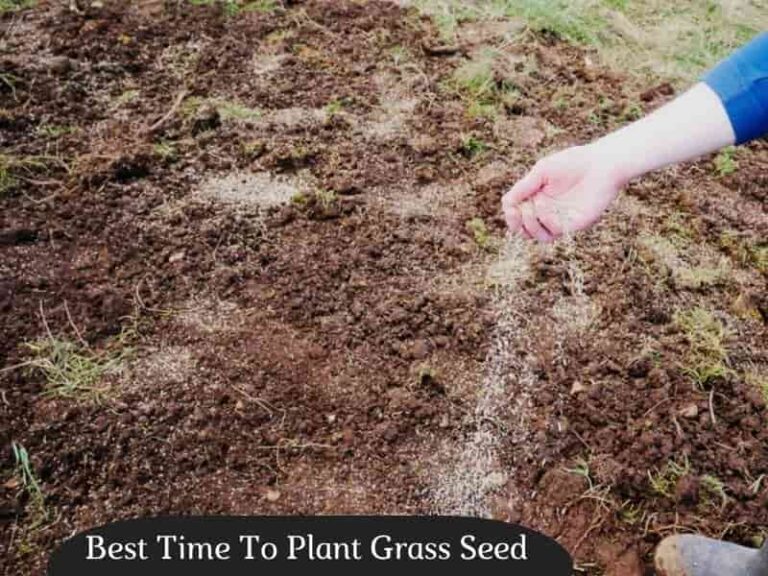

St Augustine lawn. Milorganite on schedule and at extreme rates (spreader setting maxed). Regular blade sharpening. I have a repeated yearly problems with yellowing grass in area that gets extreme sun. The rest of the lawn, and on the other side is extremely green and plush. What should I do? I did some research and landed on chelated liquid iron and have it on order to apply. Never used it. Will this fix it or do I need to do something else? I would rather not apply additional fertilizer given extreme rates of Milorganite already applied, and I’ve understood forced nitrogen growth during summer is hard on St Aug. I am learning, so I will take all input!